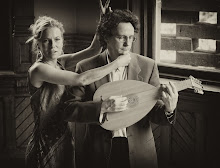

Chris and I also read through a couple of violin sonatas and chose a couple. Those are also continuo parts.
At the top is the guitar I'll be playing. It has five courses tuned like the top five of a 12-string guitar. During the late 18th century players were increasingly taking the second string of each pair off, but I will keep them on as some did. (I also like reading the tablature better than the octave treble clef.) At the very end of the century some guitars had a sixth pair, and one or two of the songs we're doing have the option of taking some notes down an octave.
Below is the Comtesse d'Egmont, who was a Spanish noblewoman who kept a salon in Paris. I think the above guitar is more like hers than the one that Madame de Pompadour is playing in the one at the bottom of this post.




1 comment:
i love the music, and i want to learn the voilan, when i enjoying the music i feel some thing good, thanks to share the infomration about the music and i hope that you will share more information about the music
Thesis Translation
Post a Comment